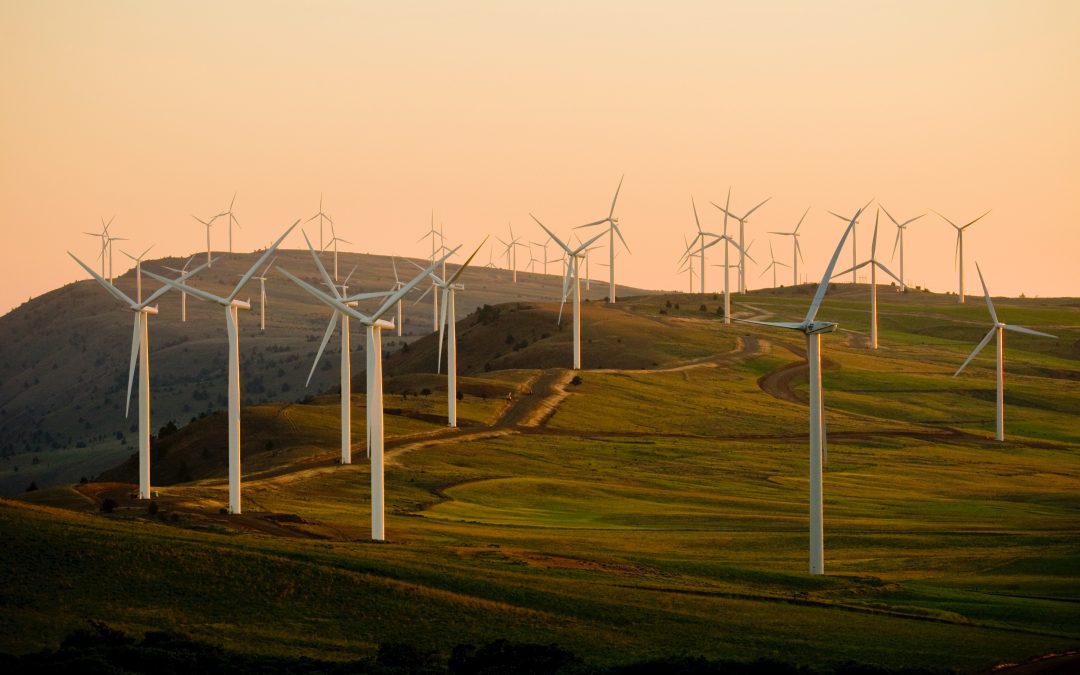
by DGR News Service | Dec 30, 2022 | ANALYSIS, Climate Change, Human Supremacy, Mining & Drilling
Editor’s note: It is true that wind and heat from the sun are renewable but the devices used to capture that energy are not. Creating such devices only adds on to a non-existing carbon budget. Richard Heinberg, the author of the following article, is an advocate for “renewable” energy as a part of the “transition” to a post carbon civilization. However, the following article demonstrates that the so-called transition is not happening in real life. In reality, civilization and a “post-carbon” future is an oxymoron. Civilization cannot survive in a post-carbon future. It is highly unlikely that humanity will willingly transition out of civilization, so it must be brought down “by any means possible”. The best way to accomplish that is through organizing. The sooner it is brought down, the better for the planet.
For more on the impracticality of renewables, read Bright Green Lies.
By Richard Heinberg / CounterPunch
Despite all the renewable energy investments and installations, actual global greenhouse gas emissions keep increasing. That’s largely due to economic growth: While renewable energy supplies have expanded in recent years, world energy usage has ballooned even more—with the difference being supplied by fossil fuels. The more the world economy grows, the harder it is for additions of renewable energy to turn the tide by actually replacing energy from fossil fuels, rather than just adding to it.
The notion of voluntarily reining in economic growth in order to minimize climate change and make it easier to replace fossil fuels is political anathema not just in the rich countries, whose people have gotten used to consuming at extraordinarily high rates, but even more so in poorer countries, which have been promised the opportunity to “develop.”
After all, it is the rich countries that have been responsible for the great majority of past emissions (which are driving climate change presently); indeed, these countries got rich largely by the industrial activity of which carbon emissions were a byproduct. Now it is the world’s poorest nations that are experiencing the brunt of the impacts of climate change caused by the world’s richest. It’s neither sustainable nor just to perpetuate the exploitation of land, resources, and labor in the less industrialized countries, as well as historically exploited communities in the rich countries, to maintain both the lifestyles and expectations of further growth of the wealthy minority.
From the perspective of people in less-industrialized nations, it’s natural to want to consume more, which only seems fair. But that translates to more global economic growth, and a harder time replacing fossil fuels with renewables globally. China is the exemplar of this conundrum: Over the past three decades, the world’s most populous nation lifted hundreds of millions of its people out of poverty, but in the process became the world’s biggest producer and consumer of coal.
The Materials Dilemma
Also posing an enormous difficulty for a societal switch from fossil fuels to renewable energy sources is our increasing need for minerals and metals. The World Bank, the IEA, the IMF, and McKinsey and Company have all issued reports in the last couple of years warning of this growing problem. Vast quantities of minerals and metals will be required not just for making solar panels and wind turbines, but also for batteries, electric vehicles, and new industrial equipment that runs on electricity rather than carbon-based fuels.
Some of these materials are already showing signs of increasing scarcity: According to the World Economic Forum, the average cost of producing copper has risen by over 300 percent in recent years, while copper ore grade has dropped by 30 percent.
Optimistic assessments of the materials challenge suggest there are enough global reserves for a one-time build-out of all the new devices and infrastructure needed (assuming some substitutions, with, for example, lithium for batteries eventually being replaced by more abundant elements like iron). But what is society to do as that first generation of devices and infrastructure ages and requires replacement?
Circular Economy: A Mirage?
Hence the rather sudden and widespread interest in the creation of a circular economy in which everything is recycled endlessly. Unfortunately, as economist Nicholas Georgescu-Roegen discovered in his pioneering work on entropy, recycling is always incomplete and always costs energy. Materials typically degrade during each cycle of use, and some material is wasted in the recycling process.
A French preliminary analysis of the energy transition that assumed maximum possible recycling found that a materials supply crisis could be delayed by up to three centuries. But will the circular economy (itself an enormous undertaking and a distant goal) arrive in time to buy industrial civilization those extra 300 years? Or will we run out of critical materials in just the next few decades in our frantic effort to build as many renewable energy devices as we can in as short a time as possible?
The latter outcome seems more likely if pessimistic resource estimates turn out to be accurate. Simon Michaux of the Finnish Geological Survey finds that “[g]lobal reserves are not large enough to supply enough metals to build the renewable non-fossil fuels industrial system … Mineral deposit discovery has been declining for many metals. The grade of processed ore for many of the industrial metals has been decreasing over time, resulting in declining mineral processing yield. This has the implication of the increase in mining energy consumption per unit of metal.”
Steel prices are already trending higher, and lithium supplies may prove to be a bottleneck to rapidly increasing battery production. Even sand is getting scarce: Only certain grades of the stuff are useful in making concrete (which anchors wind turbines) or silicon (which is essential for solar panels). More sand is consumed yearly than any other material besides water, and some climate scientists have identified it as a key sustainability challenge this century. Predictably, as deposits are depleted, sand is becoming more of a geopolitical flashpoint, with China recently embargoing sand shipments to Taiwan with the intention of crippling Taiwan’s ability to manufacture semiconductor devices such as cell phones.
To Reduce Risk, Reduce Scale
During the fossil fuel era, the global economy depended on ever-increasing rates of extracting and burning coal, oil, and natural gas. The renewables era (if it indeed comes into being) will be founded upon the large-scale extraction of minerals and metals for panels, turbines, batteries, and other infrastructure, which will require periodic replacement.
These two economic eras imply different risks: The fossil fuel regime risked depletion and pollution (notably atmospheric carbon pollution leading to climate change); the renewables regime will likewise risk depletion (from mining minerals and metals) and pollution (from dumping old panels, turbines, and batteries, and from various manufacturing processes), but with diminished vulnerability to climate change. The only way to lessen risk altogether would be to reduce substantially society’s scale of energy and materials usage—but very few policymakers or climate advocacy organizations are exploring that possibility.
Climate Change Hobbles Efforts to Combat Climate Change
As daunting as they are, the financial, political, and material challenges to the energy transition don’t exhaust the list of potential barriers. Climate change itself is also hampering the energy transition—which, of course, is being undertaken to avert climate change.
During the summer of 2022, China experienced its most intense heat wave in six decades. It impacted a wide region, from central Sichuan Province to coastal Jiangsu, with temperatures often topping 40 degrees Celsius, or 104 degrees Fahrenheit, and reaching a record 113 degrees in Chongqing on August 18. At the same time, a drought-induced power crisis forced Contemporary Amperex Technology Co., the world’s top battery maker, to close manufacturing plants in China’s Sichuan province. Supplies of crucial parts to Tesla and Toyota were temporarily cut off.
Meanwhile, a similarly grim story unfolded in Germany, as a record drought reduced the water flow in the Rhine River to levels that crippled European trade, halting shipments of diesel and coal, and threatening the operations of both hydroelectric and nuclear power plants.
A study published in February 2022 in the journal Water found that droughts (which are becoming more frequent and severe with climate change) could create challenges for U.S. hydropower in Montana, Nevada, Texas, Arizona, California, Arkansas, and Oklahoma.
Meanwhile, French nuclear plants that rely on the Rhône River for cooling water have had to shut down repeatedly. If reactors expel water downstream that’s too hot, aquatic life is wiped out as a result. So, during the sweltering 2022 summer, Électricité de France (EDF) powered down reactors not only along the Rhône but also on a second major river in the south, the Garonne. Altogether, France’s nuclear power output has been cut by nearly 50 percent during the summer of 2022. Similar drought- and heat-related shutdowns happened in 2018 and 2019.
Heavy rain and flooding can also pose risks for both hydro and nuclear power—which together currently provide roughly four times as much low-carbon electricity globally as wind and solar combined. In March 2019, severe flooding in southern and western Africa, following Cyclone Idai, damaged two major hydro plants in Malawi, cutting off power to parts of the country for several days.
Wind turbines and solar panels also rely on the weather and are therefore also vulnerable to extremes. Cold, cloudy days with virtually no wind spell trouble for regions heavily reliant on renewable energy. Freak storms can damage solar panels, and high temperatures reduce panels’ efficiency. Hurricanes and storm surges can cripple offshore wind farms.
The transition from fossil fuel to renewables faces an uphill battle. Still, this switch is an essential stopgap strategy to keep electricity grids up and running, at least on a minimal scale, as civilization inevitably turns away from a depleting store of oil and gas. The world has become so dependent on grid power for communications, finance, and the preservation of technical, scientific, and cultural knowledge that, if the grids were to go down permanently and soon, it is likely that billions of people would die, and the survivors would be culturally destitute. In essence, we need renewables for a controlled soft landing. But the harsh reality is that, for now, and in the foreseeable future, the energy transition is not going well and has poor overall prospects.
We need a realistic plan for energy descent, instead of foolish dreams of eternal consumer abundance by means other than fossil fuels. Currently, politically rooted insistence on continued economic growth is discouraging truth-telling and serious planning for how to live well with less.
Richard Heinberg is Senior Fellow of Post Carbon Institute, and is regarded as one of the world’s foremost advocates for a shift away from our current reliance on fossil fuels. He is the author of fourteen books, including some of the seminal works on society’s current energy and environmental sustainability crisis.
Featured image by American Public Power Association on Unsplash
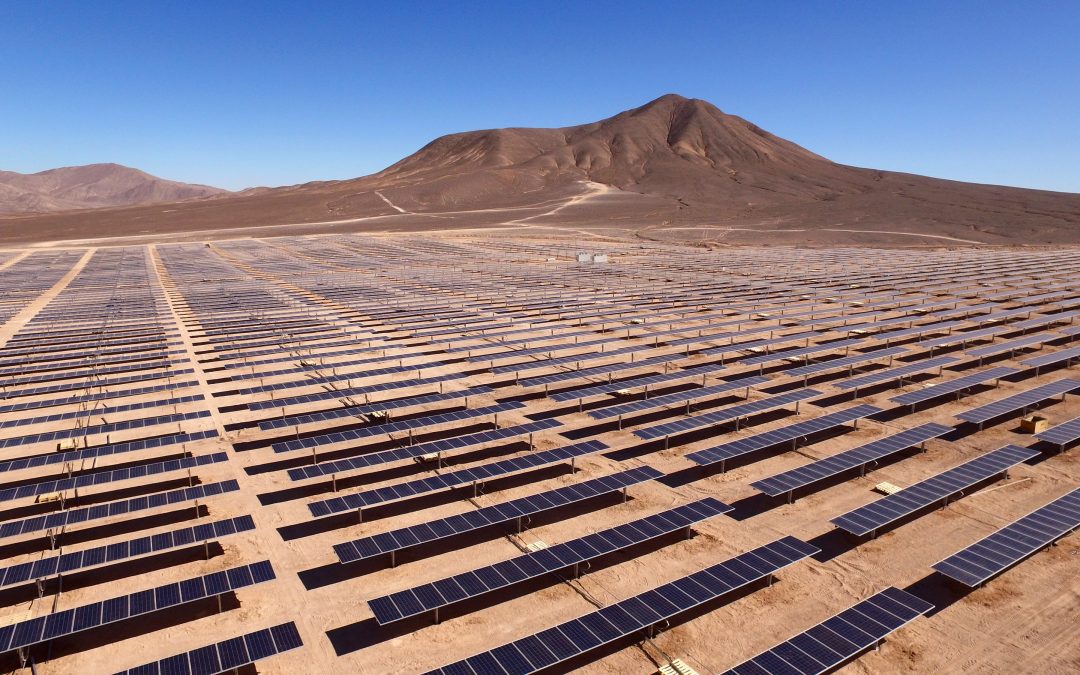
by DGR News Service | Oct 9, 2022 | ANALYSIS
Editor’s note: Contrary to what mainstream environmental organizations assert, so-called “renewable” energy is NOT a solution to the ecological crisis we are facing. It would require a tremendous amount of energy to mine materials; transport and transform them through industrial processes like smelting; turn them into solar panels, wind turbines, batteries, vehicles, infrastructure, and industrial machinery plus installation and maintenance. This is all done using the same systems of power which is currently used for conventional fossil fuels. The resulting emissions from these process will only add to the business as usual emissions. While the wind and sun may be “renewable,” the turbines, solar panels, the raw materials that go into making them, and the lands and oceans they impact certainly are not. They require tons of carbon emissions to produce so they are not carbon free and not green. Calling them “green” is greenwashing.
The proposed mass adoption of “renewable” energy on a hitherto undreamed of scale has made the issue of energy (power) density extremely important . In its simplest terms, power density can be understood as: ‘how big does my power station have to be, in order to generate the power I want?’ The most useful metric is the land (or sea) area that will be used up. Here, we encounter the most easily understood, and the most insoluble of “renewable” energy’s problems. Compared to fossil fuel, it’s power density is very very low. Thus, they require larger areas of land to produce. This land is someone’s home, someone’s sacred site, someone’s source of food, water and air. We just don’t hear about them, because they are the wild beings, the nonhumans treated as disposables by civilization. The humans that inhabit the land are indigenous peoples who are yet to be fully assimilated into the industrial culture. Here, we can see colonialism and extractive economics come together.
The following article describes the plans for different “renewable” energy plants in California and Nevada. The article also demonstrates how the plans for big “renewables” actively reinforce the existing structures of power, with the energy companies lobbying to disincentivize decentralized and community-controlled rooftop solars in favor of big projects that are destroying the neighbors.
By Joshua Frank/Counterpunch
There is a lot of hot air blowing around the West these days, blustery claims that geothermal, wind, massive solar installations, nuclear power, along with a smattering of hydroelectric dams, will help the country achieve a much-needed reduction in climate-altering emissions. Certainly, there is money to be made off of this energy transition, and on paper, a few do appear to be far less damaging than coal-fired power plants and natural gas operations.
That’s if, of course, you ignore the toll these energy ventures have on the lands and people they exploit. Right now, not far from where I live in Southern California, solar companies are gobbling up public and private lands for future solar and wind projects.
Across the border in Nevada, desert is under threat of being developed in the name of fighting climate change. In the rich and biodiverse Dixie Valley, located in the middle of sacred Shoshone and Paiute lands, a massive geothermal project called the Dixie Meadows Geothermal Development Project faced a fierce legal challenge this past year. Geothermal, like hydroelectric dams, is often cited as a renewable energy source, since the technology harnesses heat from the earth to produce electricity, which in theory (as long as it doesn’t stop raining, surprise!), is endless.
Even so, large geothermal plants consume a lot of land and spit out a lot of water. The Dixie Meadows project, which was proposed in Nevada, was one such “green” energy plan that, if built, would suck up over 40,000 thousand acre-feet of water every single year, the result of which would be devasting. Dixie’s delicate wetlands habitat, unique to this stretch of the Great Basin, is home to the imperiled black-freckled Dixie Valley toad, and even a slight alteration of surface water conditions could spell extinction for this rare little toad. Birds too use Dixie’s natural spring water as migratory stopovers. Dixie Meadows is a literal oasis in the desert and has been for tens of thousands of years.
“The United States has repeatedly promised to honor and protect indigenous sacred sites, but then the BLM approved a major construction project nearly on top of our most sacred hot springs. It just feels like more empty words,” said Fallon Paiute-Shoshone Tribal Chairwoman Cathi Tuni following the announcement of the Dixie Meadows project. “This location has long been recognized as being of vital significance to the Tribe. There are geothermal plants elsewhere in Dixie Valley and the Great Basin that we have not opposed, but construction of this plant would build industrial power plants right next to a sacred place of healing and reflection, and risks damaging the water in the springs forever. We have a duty to protect the hot springs and its surroundings, and we will do so.”
On December 16, 2021, The Fallon Paiute-Shoshone Tribe and the Center of Biological Diversity (Center) sued the BLM over its approval of the Dixie Meadows geothermal project, and in early August were successful in stopping it from moving forward.
“I’m thrilled that yet again the bulldozers are grinding to a halt as a result of our legal actions,” said Patrick Donnelly, Great Basin director at the Center. “Nearly every scientist who has evaluated this project agrees that it puts the Dixie Valley toad in the crosshairs of extinction. This agreement gives the toad a fighting shot.”
***
About 270 miles south of Dixie Meadows, another “green” energy plan is in the works near the remote Searchlight, Nevada. The Kulning Wind Project, proposed by Eolus Vind AB, a Swedish power developer, is not unlike other wind projects that were halted in 2017 and 2018 after an outcry from local Tribes and conservationists. Kulning, like the prospects that were shot down, is massive and would include 68 wind turbines spanning 9,300 acres of federal lands on the site of the proposed Avi Kwa Ame (Ah-VEE kwa-meh) National Monument. Like Dixie Meadows, Kulning would greatly impact local wildlife.
“[The] development would likely undermine the use of the region by bighorn sheep and would introduce an unnecessary wildfire risk, threatening Wee Thump and South McCullough wildernesses, among many other concerns,” says Paul Selberg, director of Nevada Conservation League. “Decisions on where to develop renewable energy must be evaluated critically and placed in areas that are appropriate.”
The real question is; are expansive energy projects, be they fossil fuels or “green”, ever really “appropriate”? Indigenous communities and conservationists are wary.
The land outside Searchlight where these huge twirling wings are to be erected is considered a sacred “place of creation” to 12 local tribes, including the Havasupai, Hualapai, Kumeyaay, Maricopa, Mojave, Pai Pai, Quechan, and Yavapai. Opponents of the development, led by a broad coalition of tribes, point out that this stretch of the Mojave is some of the most pristine, in-tact wilderness in the Southwest.
Joshua trees (known as sovarampi to the Southern Paiute) in this area, which make up the largest Joshua forest in Nevada, will be destroyed if the project moves forward. These distinctive, twisted trees are already facing a bleak future in the West. Mojave’s high desert is becoming even hotter and drier than normal, dropping nearly 2 inches from its average of just over 4.5 inches of annual rainfall just a decade ago. The result: younger Joshua trees, which grow at a snail’s pace of 3 inches per year, are perishing before they reach a foot in height. Their vanishing is an indicator that these peculiar trees will not be replenished once they grow old and die, and they are dying at a startling rate.
While it has not received as much attention as Bears Ears or Gold Butte, Avi Kwa Ame National Monument is equally important as an ecological and cultural site, which would span 450,000 acres, protecting the delicate landscape from energy developers (to support the proposed monument, you can sign a petition here).
At the center of this onslaught of development is California’s quest to end the use of fossil fuels. Most of the energy in the state, one of the largest energy consumers in the country, is generated from utility-scale wind and solar, which, as of 2016, has required over 400,000 square kilometers of land to produce. This development, because it is billed as “green” energy, has received little scrutiny from the broader environmental movement. As a result, studies on the effects on biodiversity and threatened species, like the Desert Tortoise, are virtually non-existent.
***
In Northern Nevada, a similar fight is raging over Thacker Pass, where a proposed mine would produce upwards of 80,000 tons of lithium per year, a mineral that is crucial for most electric car batteries. Lithium Nevada, the company spearheading the Thacker project, is facing strong pushback from activists and members of Fort McDermitt Paiute and Shoshone, among others.
“Places like Thacker Pass are what gets sacrificed to create that so-called clean energy,” says author and activist Max Wilbert. “It is easy to say the sacrifice is justifiable if you do not live here.”

Indigenous communities are equally upset at the plan.
“Annihilating old-growth sagebrush, Indigenous peoples’ medicines, food, and ceremonial grounds for electric vehicles isn’t very climate conscious,” said Arlan Melendez, the chair of the Reno-Sparks Indian Colony.
Opposition to the lithium mine has invigorated a new, vibrant protest movement in Nevada, led by Indigenous activists that see these developments for what they are: a continuation of settler-colonialism, an onslaught fully supported by the Democrats and the Biden Administration. In the case of EVs, Biden’s 2021 American Jobs Plan earmarked $174 billion to promote electric vehicles. The Thacker mine, claims Lithium Nevada, is central to those efforts.
There are also alternatives to lithium like seawater, sodium, and glass batteries. While none are environmentally benign, the impacts do vary. Maria Helena Braga a scientist at the University of Porto in Portugal, who has been researching glass battery technology, believes glass has the brightest future. “It’s the most eco-friendly cell you can find,” claims Braga.
Recently, researchers at the University of California San Diego’s Center for Interdisciplinary Environmental Justice disagreed that we need to mine our way out of climate change, stating that in order to curb greenhouse gas emissions we would have to decrease our output by 80% over the next thirty years. EVs, they claim, would only reduce greenhouse gases by 6%. In other words, the destruction these mines cause is not worth such little benefit. A larger, far more significant transition is needed.
***
In addition to technological advances (and the need to consume less), the energy grid itself must be revamped, from centralized sources of energy like coal or natural gas to a decentralized network of producers, where existing homes and commercial buildings are required to install solar on their rooftops. Big utilities, like PG&E in California, which has been responsible for causing over 1,500 fires and hundreds of deaths in the state, are not pleased with the push for community-controlled, decentralized power. In fact, in an effort to disincentivize rooftop solar, California regulators, after heavy lobbying from energy companies, are currently pushing to slash residential solar incentives, making the transition even more difficult, while supporting large desert developments in the process.
Hundreds of plans for large renewable energy projects are currently in the works in California, New Mexico, and Nevada, and one by one they are set to destroy vast stretches of desert habitat. In 2015, researchers from UC Berkeley and UC Riverside looked at 161 proposed and operational solar plants. What they found was startling. Only 10-15 percent of the projects in California were located in areas that would have little impact on their surroundings. In other words, 85% of these would harm the environments where they’re located.
“We would hope that if a developer was on the ground and saw that, oh, this is a really important area for migratory birds, maybe we should look at that Walmart commercial roof down the road, and collaborate with them rather than putting it here,” said the study’s lead author Rebecca Hernandez, a scientist at UC Berkeley.
While the push for decentralizing is paramount, some argue that locating green energy installations in already impacted areas, like brownfields, is a good alternative. Yet this is rarely the most profitable choice. At the heart of the problem is that public lands in the desert west are inexpensive. The Bureau of Land Management leases huge parcels of these lands for dirt cheap, which in turn incentivizes large-scale wind and solar projects — projects that support Biden’s climate plan, where companies like PG&E will continue to control the grid and small-scale projects will be difficult and expensive to build.
If the goal of clean, green energy is to offset the wrath of climate catastrophe, yet damages sensitive habitats in the process, are these projects even worthwhile? That’s a question environmentalists and others must grapple with. Certainly, they are good for profit margins, but the evidence is mounting that they are also devastating to desert ecology.
JOSHUA FRANK is the managing editor of CounterPunch. He is the author of the forthcoming book, Atomic Days: The Untold Story of the Most Toxic Place in America, published by Haymarket Books. He can be reached at joshua@counterpunch.org. You can troll him on Twitter @joshua__frank.
Featured image by Antonio Garcia via Unsplash

by DGR News Service | Sep 30, 2022 | NEWS, The Problem: Civilization
Editor’s Note: DGR does not support solar and wind “alternatives”. They are not alternatives to the energy and ecological crisis, but rather a part of it.. They do not “replace” natural gas and fossil fuels, not only because the so called renewable energy are not as potent an energy source as fossil fuel, but also because they rely on fossil fuel for basic operation. They contribute to the abuse, exploitation and plunder of nature. There are mountains of resources to support this. More dangerously, they lead us to false solutions, putting our much needed revolutionary energies into projects which only contribute to the problem. We are firmly opposed to these technologies.
The value of this article lies in exposing how these “green” technologies are being introduced in reality. Despite the bright green lies in this article, it is important to gain understanding on how these technologies are wrecking havoc across the globe. The beauty of nature is defended strongly in this article. The “violent mechanization of [the] daily view of the natural world” is acknowledged to be a deep concern, indeed it is “extremely disturbing”. In the spirit of solidarity and internationalism, we call for coalitions to ask important questions on these “green” and “alternative” technologies, and to continue the ecological resistance to protect the wild.
by Evaggelos Vallianatos
My Greek friends in the large island of Euboea and Boeotia (Central Greece) are telling me — and the world — that a “hurricane” of solar and wind technologies are wrecking their lives and the countryside.
I am all for solar and wind alternatives to the Earth-warming fossil fuels. The faster they replace dangerous petroleum, natural gas, and coal, the better. The world is in real danger from anthropogenic climate chaos. Climate nemesis is hanging over the planet like the sword of Damokles.
Nevertheless, Greece has been abusing solar and wind energy. Instead of placing solar panels on the roofs of houses and buildings, the local Greek municipal governments and the Ministry of the Environment are licensing private companies to install solar panel arrays on archaeological sites, wetlands, valleys, and mountains.
The situation with wind turbines, some of which are gigantic and 200 meters tall, is worse. Private companies flatten mountain tops, clear cut forests, dig up valleys and mountain sides for the construction of large cement foundations for their monster wind turbines. They act like the ruthless coal companies in Kentucky and West Virginia.
Euboea
In Central Euboea, there’s an exquisite wetland named Kolobrextis. This wetland supports a number of threatened and endangered species. It is close to an archaeological site. And yet both the archaeological service and the Ministry of the Environment permitted the installation of numerous solar panels in the region of Kolobrextis. Local citizens appealed these illegal decisions, but without success.
They said:
“We consider the wetland our natural inheritance, which cannot be sacrificed on the altar of the interests and profits of a corrupt and unethical market.”
On July 17, 2022, Evi Sarantea, an artist and environmentalist from Euboea, sent the following letter to her friends:
“[Government authorities licensing windfarms] intend to destroy the last dense fir forest left in Central Evia [Euboea]… They already destroyed Southern Evia. They authorized the placement of more than 800 wind turbines in an extensive archaeological site. Some of those wind turbines were about 185 meters tall. And this happened after Northern Evia was incinerated last year. Don’t let this HUBRIS win. ALL the Municipalities and 150 agencies of the island [of Euboea] are 100 percent opposed to the installation of these monsters – with a life span of only 20 years. They will irreversibly and tragically destroy the ecosystem and the formation of the soil which is several tens of millions of years old.”
Boeotia
Boeotia is a prosperous region with rich mythology and history. Its poleis (city-states) Orchomenos and Thebes date from the Bronze Age. Thebes gave Greece god Dionysos and the superhero Herakles and the great lyric poet Pindar.
In July 2022, however, citizens in Central Greece spoke about widespread vandalism and ecological and cultural destruction of mountains sacred in Bronze Age Greece and classical times: Parnassos, Helicon, Cithaeron, and Parnetha.
Hesiod, born in Ascra, a village of Boeotia and second poet only to Homer, was inspired to write his epics on the birth of the gods and rural life by the Muses, goddesses of learning. The inspiration took place on Mt. Helicon.
Sowing wind turbines
And now, in 2022, more than three thousand years after Hesiod, the Greek government serving its debt masters in the European Union and the United States, especially Germany, is blowing up sacred nature in order to dig the giant wind towers from Germany very deeply into fertile land and mountains.
This fast-paced degrading of archaeological sites, and destruction of the natural world in Greece (mountains, forests, wetlands, and land) is socking the Greek people. They don’t know or suspect the reasons behind the vandalism. The government is promising cheap energy prices for their cooperation. But the prices of energy keep increasing.
The citizens are accusing their government of corruption. It allows profiteers and an immoral and unchecked market to undermine and destroy the natural world. This new ugly mechanical and shining solar icons will be throwing people in doubt about climate change and the means of fighting it. They will remember petroleum and coal with nostalgia and pleasure. In essence, this unchecked and nature-deforming energy development will be giving a bad name to solar and wind energy.
The citizens of Boeotia mentioned “the permitting of 38 large wind and solar parks consisting of hundreds of wind turbines and thousands of solar panels.”
Spoiling beauty – and much more
This prospect of the violent mechanization of their daily view of the natural world is extremely disturbing. The citizens of Boeotia complain that,
“Probably all the mountains and forests of Boeotia are slated for attacks from the energy industry. This would transform the natural world beyond recognition. Beekeeping would be abandoned; cattle raising outside of animal farms would also come to an end; cultivating the land for food, tourism, and relaxation in the countryside will be undermined, and eventually abandoned. Trees, bushes, wild animals, and birds are in immediate danger. Wind turbines on the top of mountains will decimate eagles, falcons, and other birds of prey, already under stress of extinction.”
This unnecessary tragedy adds considerably to the unhappiness and debt misery of the Greeks. They are bound to see the finger of Germany behind this onslaught on their few surviving pleasures: walking to the woods in the mountains and forests and valleys; seeing the rare birds of wetlands; and paying their respects to the quiet and beauty spread above the ruins in archaeological sites.
Stop this madness
My advice to the Prime Minister Kyriakos Mitsotakis would be to break with the humiliations of the debt. Stop paying the illegal and odious debt. Return to the drachma. And reindustrialize your country. Stop using the German wind behemoths. Build your own wind-electricity generating machines to fit the country’s ecological and climate needs. Indeed, design and build all technologies at home.
Greece used to worship the Sun god Helios and Aiolos, the god of the winds. Yes, Greece needs to stop using fossil fuels, but it also needs to use solar panels only on the rooftops of houses and buildings. And should there be a need for windfarms, always plan and act in the context of ecology, biodiversity, and culture. If the windfarms cannot be used without harm, forget about them. Don’t use them in Greece.
Evaggelos Vallianatos is a historian and environmental strategist, who worked at the US Environmental Protection Agency for 25 years. He is the author of seven books, including the latest book, The Antikythera Mechanism.
Ship of Stars
they abducted the stars
got masses of people
to believe in separate Gods
this went on and on
for millennia
till masses of people
forgot that the star-beings
are pulsating with lights
how the stars literally
guide us, birds at night,
us in our dreams, astral travel
forgetting the star-beings,
masses of people
became mis-guided
embroiled in dis-asters
dis- and ster-
“away from the stars”
if i could find a statistic
that shows dis-asters have increased
in modern times as the masses became less
aware of, conscious of, less guided by the stars
i would footnote that
so instead
you’ll have to step outside or
look out a window or
find the lights within
and then you’ll remember
who star-beings are
and
what star-beings do
Mankh (Walter E. Harris III) is a verbiage experiencer, in other words, he’s into etymology, writes about his experiences and to encourage people to learn from direct experiences, not just head knowledge; you know, actions and feelings speak louder than words. He’s also a publisher and enjoys gardening, talking, listening, looking… His recent book is Moving Through The Empty Gate Forest: inside looking out. Find out more at his website: www.allbook-books.com

by DGR News Service | Jun 17, 2022 | ANALYSIS
Editor’s note: As the climate catastrophe worsens, chaos and contradiction reigns. Grassroots people’s resistance to the fossil fuel industry is growing, but so is government repression, and investment in coal, oil, and gas continues to grow (last year, more than 83% of global energy was supplied by fossil fuels). Meanwhile, governments are censoring the true depths of the crisis and a rush of big-businesses are seeking to capitalize on global warming, seeing a massive “shock doctrine” opportunity for profiting off the crisis.
Today we bring you an excerpt from the book Bright Green Lies: How the Environmental Movement Lost Its Way and What We Can Do About It by Derrick Jensen, Lierre Keith, and Max Wilbert, a book which Chris Hedges says “asks the questions most refuse to ask, and in that questioning, that seeking, uncovers profound truths we ignore at our peril.”
This excerpt uses Naomi Klein’s concept of the “Shock Doctrine” to analyze how big business has co-opted the environmental movement into a de-facto lobbying arm for the so-called “green” technology industry, and in the process has turned away from the fundamental values of the environmentalism.
 It shouldn’t surprise us that the values of the environmental movement have degraded so much in the last 30 years.
It shouldn’t surprise us that the values of the environmental movement have degraded so much in the last 30 years.
Now more than ever, people are immersed in technology instead of the real world. As one report states, “The average young American now spends practically every minute—except for time in school—using a smart- phone, computer, television or electronic device.” A recent poll in Britain found that the average 18-to-25-year-old rated an internet connection as more important than daylight.
We’ve come a long way from the naturalists we were born to be; from inhabiting a living world flush with kin to serving a society in thrall to machines.
It’s no wonder, then, that so many people believe in nonsensical technological solutions. Technology does it for them and the real world doesn’t.
And so, the absurd becomes normal. We hear that green technology will stop global warming. We hear that cutting down forests and burning them is good for the planet. We hear that damming rivers is good for the planet. We hear that destroying the desert to put in solar panels is good for the planet. We hear that industrial recycling will save the world. We hear that commodifying nature is somehow significantly different than business as usual. We hear that we can invest our way to sustainable capitalism. We hear that capitalism can be sustainable.
A global growth rate of 3 percent, which is considered the mini- mum for capitalism to function, means the world economy doubles every 24 years. This is, of course, madness. If we can’t even name capitalism as a problem, how are we to have any chance of saving the planet?
There’s no doubt that global warming is apocalyptic. I (Max) have stood on thawing permafrost above the Arctic Circle and seen entire forests collapsing as soils lose integrity under their roots. This culture is changing the composition of the planet’s climate. But this is not the only crisis the world is facing, and to pretend otherwise ignores the true roots of the problem.
The Sierra Club has a campaign called “Ready for 100.” The campaign’s goal is to “convince 50 college campuses, a dozen key cities and half a dozen key states to go 100 percent renewable.’” The executive director of the Sierra Club, Michael Brune, explains,
“There are a few reasons why Ready for 100 is working—why it’s such a powerful idea. People have agency, for one. People who are outraged, alarmed, depressed, filled with despair about climate change—they want to make a difference in ways they can see, so they’re turning to their backyards. Turning to their city, their state, their university. And, it’s exciting—it’s a way to address this not just through dread, but with something that sparks your imagination.”
There are a lot of problems with that statement. First, is Ready for 100 really “working,” like Brune says? That depends on the unspoken part of that statement: working to achieve what? He may mean that the campaign is working to mobilize a larger main- stream climate movement. He may mean that Ready for 100 is working in the sense that more “renewable” infrastructure is being built, in great measure because more subsidies are being given to the industry.
If he means Ready for 100 is working to reduce the burning of coal, oil, and gas—which is, in fact, what he means—he’s dead wrong, as “fossil fuels continue to absolutely dominate global energy consumption.”
There’s more about Brune’s quote that’s bothersome. He’s explicitly turning people’s “outrage, alarm, depression, and despair” into means that serve the ends of capital; through causing people to use these very real feelings to lobby for specific sectors of the industrial economy.
If a plan won’t work, it doesn’t matter if people have “agency.” The ongoing destruction of the planet, and the continued dominance of coal, oil, and gas, seems to be less important than diverting people’s rage—which, if left unchecked, might actually explode into something that would stop capitalism and industrialism from murdering the planet—into corporate-friendly ends.
Led by 350.org, the Fossil Free campaign aims to remove financial support for the coal, oil, and gas industries by pressuring institutions such as churches, cities, and universities to divest. It’s modeled on the three-pronged boycott, divestment, and sanctions (BDS) resistance to South African apartheid (a model used today against Israel). The Fossil Free campaign has thus far pressured 800 institutions and 58,000 individuals to divest $6 trillion. Some of these are partial divestments, such as withdrawing from tar sands but continuing to fund fracking.
Still, sounds great, right? Anyone fighting to stop coal, oil, and gas is doing a very good thing.
But given how little time we have, and how badly we’re losing the fight for the planet, we have to ask if divestment is an effective strategy.
The answer, unfortunately, is not really. Jay Taber of Intercontinental Cry points out that “All this divestment does is make once publicly held shares available on Wall Street, which allows trading houses like Goldman Sachs to further consolidate their control of the industry. BDS, when applied against apartheid states by other states and international institutions, includes cut- ting off access to finance, as well as penalties for crimes against humanity.” He states quite bluntly that divestment acts to “redirect activism away from effective work.”
Bill Gates—not usually someone we’d listen to—seems to agree. “If you think divestment alone is a solution,” Gates writes, “I worry you’re taking whatever desire people have to solve this problem and kind of using up their idealism and energy on something that won’t emit less carbon—because only a few people in society are the owners of the equity of coal or oil companies.”
If it occurs on a wide enough scale, divestment makes previously held stocks, bonds, and other investment products available for purchase. This glut drops prices, making it easier for less ethical investors to buy. This not only consolidates the industry, but it also makes fossil fuel stocks more profitable for those who snatch them up. As journalist Christian Parenti writes, “So how will dumping Exxon stock hurt its income, that is, its bottom line? It might, in fact, improve the company’s price to earnings ratio thus making the stock more attractive to immoral buyers. Or it could allow the firm to more easily buy back stock (which it has been doing at a massive scale for the last five years) and thus retain more of its earnings for use to develop more oil fields.”
It’s unlikely any divestment campaigner believes divestment alone will stop global warming. The Fossil Free website recognizes this, writing: “The campaign began in an effort to stigmatize the Fossil Fuel industry—the financial impact was secondary to the socio-political impact.” But as the amount of money being divested continues to grow, reinvestment is becoming a more central part of the fossil fuel divestment campaign. The website continues: “We have a responsibility and an opportunity to ask ourselves how moving the money itself … can help us usher forth our vision.”
Great! So, they’re suggesting these organizations take their money out of oil industry stocks, and use that money to set aside land as wilderness, for wild nature, right?
Well, no. They want the money to be used to fund “renewable energy.” And they’ve slipped a premise past us: the idea that divestment and reinvestment can work to create a better world. It’s an extraordinary claim, and not supported by evidence. As Anne Petermann of the Global Justice Ecology Project writes, “Can the very markets that have led us to the brink of the abyss now provide our parachute? … Under this system, those with the money have all the power. Then why are we trying to reform this system? Why are we not transforming it?”
Activist Keith Brunner writes, “Yes, the fossil fuel corporations are the big bad wolf, but just as problematic is the system of investment and returns which necessitates a growth economy (it’s called capitalism).” His conclusion: “We aren’t going to invest our way to a livable planet.”
Is it better to fight for “achievable, realistic” goals through reform, or address the fundamental issues at their root? Usually, we’re in favor of both. If we wait for the great and glorious revolution and don’t do any reform work (which we could also call defensive work), by the time the revolution comes, the world will have been consumed by this culture. And if we only do defensive work and don’t address the causes of the problems, this culture will consume the world until there’s nothing left.
But it’s pretty clear that the real goal of the bright greens isn’t defending the planet: Everyone from Lester Brown to Kumi Naidoo has been explicit about this. The real goal is to get money into so-called green technology. A recent article notes, “Climate solutions need cold, hard cash … about a trillion a year.”
One of Naomi Klein’s biggest contributions to discourse is her articulation of the “shock doctrine,” which she defines as “how America’s ‘free market’ policies have come to dominate the world—through the exploitation of disaster-shocked people and countries.” In her book The Shock Doctrine: The Rise of Disaster Capitalism, Klein explains—brilliantly—how the same principles used to disorient and extract concessions from victims of torture can be leveraged to extract political concessions from entire nations in the wake of major disasters. She gives many examples, including the wave of austerity and privatization in Chile following the Pinochet coup in 1973, the massive expansion of industrialism and silencing of dissidents following the Tienanmen Square massacre in China in 1989, and the dismantling of low-income housing and replacement of public education with for-profit schools in New Orleans in the wake of Hurricane Katrina in 2005.
The shock doctrine also perfectly describes the entire bright green movement: Because of a terrible and very real disaster (in this case, climate change), you need to hand over huge subsidies to a sector of the industrial economy, and you need to let us destroy far more of the natural world, from Baotou to the Mojave Desert to the bottom of the ocean. If you don’t give us lots of money and let us destroy far more of the natural world, you will lose the luxuries that are evidently more important to you than life on the planet.
Once you start looking for this trend, it’s really clear. There’s a 2016 article in Renewable Energy World magazine about the Desert Renewable Energy and Conservation Plan. The plan allows major solar energy harvesting facilities to be built in some areas of the California desert, but not other areas. Shannon Eddy, head of the Large-Scale Solar Association, considers protecting parts of the desert “a blow.” She says, “The world is on fire—CO2 levels just breached the 400-ppm threshold. We need to do everything we can right now to reduce emissions by getting renewable projects online.”
Everything including destroying the desert. This is reminiscent of a phrase from the Vietnam War era, which originated in 1968 with AP correspondent Peter Arnett: “‘It became necessary to destroy the town to save it,’ a United States major said today.”
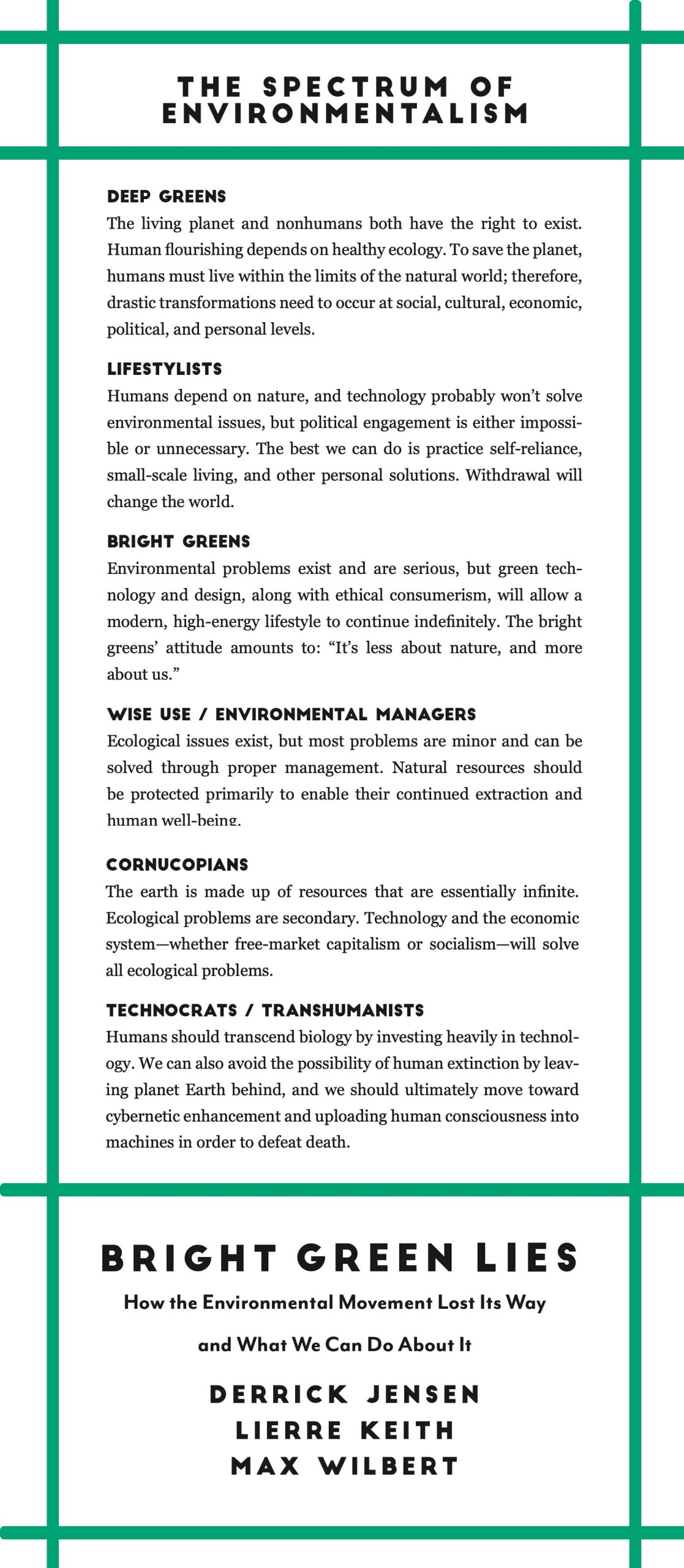
If you enjoyed this excerpt, you can order the book Bright Green Lies: How the Environmental Movement Lost Its Way and What We Can Do About It to your local bookstore or anywhere you find books. It’s also available in audiobook format on Audible and other platforms.
We also invite readers to get involved in people’s movements against greenwashing and for degrowth, resistance to industrial civilization, humane population reduction, and for the land. You can learn more about an active struggle over these issues at Protect Thacker Pass.

by DGR News Service | May 20, 2022 | Mining & Drilling, NEWS
Editor’s note: As global warming and ecological collapse accelerates, governments and corporations are unwilling to invest in real solutions. Instead, public fear is increasingly being weaponized to mobilize public subsidies for the so-called “green technology” industry, and a new sacrifice zone is emerging.
For example, instead of moving to relocalize and reduce energy use, electric cars are being promoted as a “plug-and-play” substitute for gasoline cars. This approach will do nothing to halt the ecological crisis, will only negligibly reduce rising greenhouse gas emissions, and is accelerating new harms such as an explosion in mining for lithium, cobalt, copper, and other materials.
It’s Not Just Thacker Pass. The Entire Region is on the Chopping Block.
by Elisabeth Robson / Protect Thacker Pass
In their June 2021 Fact Sheet about the Thacker Pass Lithium Mine Project, Lithium Americas includes a two page document about biodiversity at Thacker Pass and claim they have engineered the project “to minimize its environmental footprint.” On the second page is a map showing the Thacker Pass Project area in the bottom part of the McDermitt Caldera, which straddles the border of Nevada and Oregon.
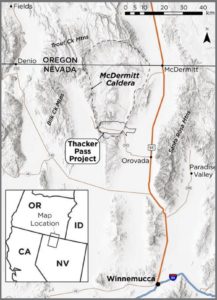 Lithium Americas claims that protecting the Montana Mountains is their priority, writing “Lithium Americas made the decision in 2018 to move the project south of the Montana Mountains to avoid disturbing sensitive ecological areas located within the mountains,” and that “[T]he project will not involve any direct physical disturbance of sage grouse leks or golden eagle nests”.
Lithium Americas claims that protecting the Montana Mountains is their priority, writing “Lithium Americas made the decision in 2018 to move the project south of the Montana Mountains to avoid disturbing sensitive ecological areas located within the mountains,” and that “[T]he project will not involve any direct physical disturbance of sage grouse leks or golden eagle nests”.
Putting aside for the moment that any industrial disturbance to the Thacker Pass area will have significant impacts on wildlife and sensitive areas, including pronghorn who migrate through Thacker Pass, many species of birds, including sage-grouse who are exquisitely sensitive to noise, and countless other species who call Thacker Pass home or rely on it for some part of their life cycle, one might believe, reading their propaganda, that Lithium Americas is going to limit the scope of their mining operations in Thacker Pass to the project area already defined for the Thacker Pass mine. If you think that, you’d be wrong.
In the article “Proposed lithium mine raises worries in Humboldt County” in the Las Vegas Sun on May 3, 2022, Lithium Nevada Corporation, a subsidiary of Lithium Americas, claims again that the project is designed to “avoid environmentally sensitive and rugged terrain”. However, they also say that the project allows for future potential expansions. Lithium Nevada made these plans for potential expansion clear in the project documents the company filed with the SEC and with the Environmental Impact Statement, so this is no secret.
The same article quotes John Hadder, director of Great Basin Resource Watch, who says that in the future a series of mines could line the Montana mountain range, creating, as he says, an “enormous mining district”.
The “Independent Technical Report for the Thacker Pass Project, Humboldt County, Nevada, USA” document filed with the SEC by Lithium Americas on February 15, 2018, includes a map that illustrates the plans the company has for the region, showing the area of Lithium Nevada Corporation’s mining claims and the known areas of lithium mineralization. This map shows the claims and potential mining areas stretching at least 30 miles north of Thacker Pass, through the heart of the Montana Mountains, the last great sage-grouse habitat on the planet.
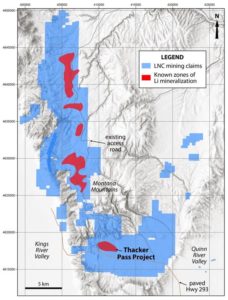 Why, then, does the company say in their 2-page fact sheet that they moved the Thacker Pass project south to avoid disturbing sensitive ecological areas within the mountains when they have every intention of expanding the mining project into the Montana Mountains where the sage-grouse leks are located? Do they believe that once the first project is begun, it will be easier to get further mining projects in the region approved?
Why, then, does the company say in their 2-page fact sheet that they moved the Thacker Pass project south to avoid disturbing sensitive ecological areas within the mountains when they have every intention of expanding the mining project into the Montana Mountains where the sage-grouse leks are located? Do they believe that once the first project is begun, it will be easier to get further mining projects in the region approved?
This projected expansion by Lithium Nevada and its parent company, Lithium Americas, along with the two other large lithium claims on the Oregon side of the border, one in the McDermitt Caldera by Australian company Jindalee Resources Limited and the other just outside the Caldera by Acme Lithium Inc., will turn this entire region into a fully industrialized area with roads, mining pits, refineries, waste dumps, a dramatic increase in truck and other vehicle traffic, and new housing and/or man camps and other developments to support the many hundreds if not thousands of workers that will be required to mine the area.
To understand the scope and scale of what is being proposed here, take a look at the mining plans illustrated in three images from the three mining companies—Lithium Nevada, Jindalee, and Acme—combined into one:
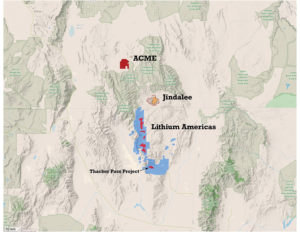
Image created by Protect Thacker Pass
As Kale Telage writes in “Lithium Americas: Yesterday, Today and Tomorrow” on the investing site Seeking Alpha on April 26, 2022, “Thacker Pass may just be the beginning.” The land, the wild beings, and the local people of this area are in for a shock. If built, these industrial projects will utterly and irrevocably destroy this wild and quiet region currently thrumming with life and beauty and turn it forever into a wasteland.
What are the roots that clutch, what branches grow
Out of this stony rubbish? Son of man,
You cannot say, or guess, for you know only
A heap of broken images, where the sun beats,
And the dead tree gives no shelter, the cricket no relief,
And the dry stone no sound of water. Only
There is shadow under this red rock,
(Come in under the shadow of this red rock),
And I will show you something different from either
Your shadow at morning striding behind you
Or your shadow at evening rising to meet you;
I will show you fear in a handful of dust.
— T.S. Eliot, The Waste Land
Featured image: Max Wilbert











